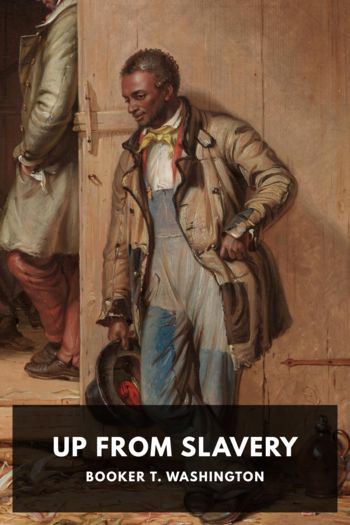Up from Slavery by Booker T. Washington (highly recommended books .TXT) 📕

Description
Booker Taliaferro Washington began life as a slave in Virginia shortly before emancipation, but rose to become one of the most celebrated leaders the African American community has ever had. His principal occupation was as president of the Tuskegee Institute, which he founded in 1881, but he earned national renown as an orator, writer and political advisor. His address at the Atlanta Exposition was a pivotal moment in race relations in America.
Washington believed deeply in the dignity of physical labor, and that merit and talent are eventually rewarded regardless of race or class. The Tuskegee Institution was primarily a technical college, and aimed to teach industrial skills in addition to academic training. Students built many of the buildings on the campus, grew the food that was eaten there, and even made the furniture, tools and vehicles used by the school.
Up from Slavery was originally published as a serialized work in The Outlook, a Christian magazine based in New York, before being collected in a single volume in 1901. This edition includes an introduction by Walter H. Page, a future U.S. ambassador to the United Kingdom.
Read free book «Up from Slavery by Booker T. Washington (highly recommended books .TXT) 📕» - read online or download for free at americanlibrarybooks.com
- Author: Booker T. Washington
Read book online «Up from Slavery by Booker T. Washington (highly recommended books .TXT) 📕». Author - Booker T. Washington
From the very beginning, at Tuskegee, I was determined to have the students do not only the agricultural and domestic work, but to have them erect their own buildings. My plan was to have them, while performing this service, taught the latest and best methods of labour, so that the school would not only get the benefit of their efforts, but the students themselves would be taught to see not only utility in labour, but beauty and dignity; would be taught, in fact, how to lift labour up from mere drudgery and toil, and would learn to love work for its own sake. My plan was not to teach them to work in the old way, but to show them how to make the forces of nature—air, water, steam, electricity, horsepower—assist them in their labour.
At first many advised against the experiment of having the buildings erected by the labour of the students, but I was determined to stick to it. I told those who doubted the wisdom of the plan that I knew that our first buildings would not be so comfortable or so complete in their finish as buildings erected by the experienced hands of outside workmen, but that in the teaching of civilization, self-help, and self-reliance, the erection of buildings by the students themselves would more than compensate for any lack of comfort or fine finish.
I further told those who doubted the wisdom of this plan, that the majority of our students came to us in poverty, from the cabins of the cotton, sugar, and rice plantations of the South, and that while I knew it would please the students very much to place them at once in finely constructed buildings, I felt that it would be following out a more natural process of development to teach them how to construct their own buildings. Mistakes I knew would be made, but these mistakes would teach us valuable lessons for the future.
During the now nineteen years’ existence of the Tuskegee school, the plan of having the buildings erected by student labour has been adhered to. In this time forty buildings, counting small and large, have been built, and all except four are almost wholly the product of student labour. As an additional result, hundreds of men are now scattered throughout the South who received their knowledge of mechanics while being taught how to erect these buildings. Skill and knowledge are now handed down from one set of students to another in this way, until at the present time a building of any description or size can be constructed wholly by our instructors and students, from the drawing of the plans to the putting in of the electric fixtures, without going off the grounds for a single workman.
Not a few times, when a new student has been led into the temptation of marring the looks of some building by leadpencil marks or by the cuts of a jackknife, I have heard an old student remind him: “Don’t do that. That is our building. I helped put it up.”
In the early days of the school I think my most trying experience was in the matter of brickmaking. As soon as we got the farm work reasonably well started, we directed our next efforts toward the industry of making bricks. We needed these for use in connection with the erection of our own buildings; but there was also another reason for establishing this industry. There was no brickyard in the town, and in addition to our own needs there was a demand for bricks in the general market.
I had always sympathized with the “Children of Israel,” in their task of “making bricks without straw,” but ours was the task of making bricks with no money and no experience.
In the first place, the work was hard and dirty, and it was difficult to get the students to help. When it came to brickmaking, their distaste for manual labour in connection with book education became especially manifest. It was not a pleasant task for one to stand in the mud-pit for hours, with the mud up to his knees. More than one man became disgusted and left the school.
We tried several locations before we opened up a pit that furnished brick clay. I had always supposed that brickmaking was very simple, but I soon found out by bitter experience that it required special skill and knowledge, particularly in the burning of the bricks. After a good deal of effort we moulded about twenty-five thousand bricks, and put them into a kiln to be burned. This kiln turned out to be a failure, because it was not properly constructed or properly burned. We began at once, however, on a second kiln. This, for some reason, also proved a failure. The failure of this kiln made it still more difficult to get the students to take part in the work. Several of the teachers, however, who had been trained in the industries at Hampton, volunteered their services, and in some way we succeeded in getting a third kiln ready for burning. The burning of a kiln required about a week. Toward the latter part of the week, when it seemed as if we were going to have a good many thousand bricks in a few hours, in the middle of the night the kiln fell. For the third time we had failed.
The failure of this last kiln left me without a single dollar with which to make another experiment. Most of the teachers advised the abandoning of the effort to make bricks. In the midst of my troubles I thought of a watch which had come into my possession years before. I took the watch to





Comments (0)